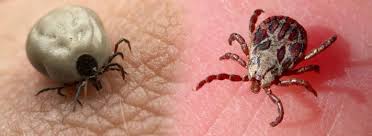” It ‘s Tick’s time… “
/ cvjavea

Ticks are parasites that feed on the blood of its host, belonging to the Arachnida class and subclass Acari (mites). There are two recognized families of ticks, Ixodidae Fam which also are called hard ticks mostly affecting mammals, including humans and Fam Argasidae which are called soft ticks and primarily affect birds.
The male is smaller than the female and it is the female the ona that may increase in size by feeding on the blood of its host. Ticks are often found in groups of two, four or more together in a small area of the animal’s body. The most common places where you find ticks on dogs and cats are around the eyes, at the base of the ears, between the toes, in the folds of skin in the abdomen or around the anus. These mites require a blood meal to survive during all phases of their life, this means that in young stages must join a host quickly to draw blood and thus move to the next phase of their life cycle until they reach adulthood. The adult female tick fed once its belly is full and then it releases to fall and lay eggs in the grass. They can lay up to 3000 eggs. After hatching, juvenile ticks climb amount to the highlands of herbs where wait after a possible host to which is invaded by direct contact, do not jump to it.
Ticks cause direct harm to their hosts and are the mode of transmission of pathogens that cause severe disease in people and animals.
Direct damage
The tick bite causes tissue destruction and local inflammatory reaction due to its mouthparts, resulting in the formation of nodules on the skin that may be pruritic and painful. They can also lead to toxicosis produced by the direct release of toxins with tick saliva that may cause paralysis and even death of the animal. They can also cause severe anemia from blood loss. Likewise, saliva has immunosuppressive substances that favor the spread of infection.
Tick-borne diseases
Ticks are major vectors of diseases in domestic and wild animals, many of which are zoonoses affecting humans and are quite serious. Infections most often transmitted to pets are Babesiosis, Ehrlichiosis and Anaplasmosis and new diseases are emerging especially affecting the dog and cat as Bartonellosis, Lyme disease and tick-borne encephalitis that is most important in the human being.
Control of tick populations
It is best to use a preventive acaricide which can be applied in bathrooms, sprays or treatments “spot on” and necklaces. Among the most effective products found Amitraz, permethrin, Pyriprole, Flumethrin and Fipronil in products whose trade names are Certifect, Exspot, Prac-tic, Seresto or Frontline. All of them very effective but remembering to apply once a month or lose the protective efficacy and renew the collars with the frequency indicated by your veterinarian
Also useful to spray the legs and lower abdomen our dog repellent spray (fipronil, permethrin) before taking a stroll through an area with grass or in the country, to prevent any ticks climb. It is also convenient to explore the animal after one of these trips to eliminate the garraptas Hayn had access to before they are installed in our animal.
At present vaccines are developed and used ticks in cattle and can be interesting in the future

Leave a Reply